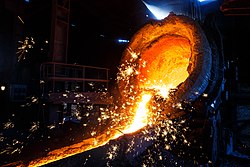
Back Maraging-Stahl German فولاد مارایجینگ Persian Acier maraging French Maraging čelik Croatian Acciaio maraging Italian マルエージング鋼 Japanese Stal maraging Polish Aço maraging Portuguese Мартенситностареющие стали Russian Maraging čelik Serbo-Croatian
| Steels |
|---|
 |
| Phases |
| Microstructures |
| Classes |
| Other iron-based materials |
Maraging steels (a portmanteau of "martensitic" and "aging") are steels that are known for possessing superior strength and toughness without losing ductility. Aging refers to the extended heat-treatment process. These steels are a special class of very-low-carbon ultra-high-strength steels that derive their strength not from carbon, but from precipitation of intermetallic compounds. The principal alloying element is 15 to 25 wt% nickel.[1] Secondary alloying elements, which include cobalt, molybdenum and titanium, are added to produce intermetallic precipitates.[1] Original development (by Bieber of Inco in the late 1950s) was carried out on 20 and 25 wt% Ni steels to which small additions of aluminium, titanium, and niobium were made; a rise in the price of cobalt in the late 1970s led to the development of cobalt-free maraging steels.[2]
The common, non-stainless grades contain 17–19 wt% nickel, 8–12 wt% cobalt, 3–5 wt% molybdenum and 0.2–1.6 wt% titanium.[3] Addition of chromium produces stainless grades resistant to corrosion. This also indirectly increases hardenability as they require less nickel; high-chromium, high-nickel steels are generally austenitic and unable to transform to martensite when heat treated, while lower-nickel steels can transform to martensite. Alternative variants of nickel-reduced maraging steels are based on alloys of iron and manganese plus minor additions of aluminium, nickel and titanium where compositions between Fe-9wt% Mn to Fe-15wt% Mn have been used.[4] The manganese has a similar effect as nickel, i.e. it stabilizes the austenite phase. Hence, depending on their manganese content, Fe-Mn maraging steels can be fully martensitic after quenching them from the high temperature austenite phase or they can contain retained austenite.[5] The latter effect enables the design of maraging-TRIP steels where TRIP stands for Transformation-Induced-Plasticity.[6]
- ^ a b Degarmo, E. Paul; Black, J. T.; Kohser, Ronald A. (2003), Materials and Processes in Manufacturing (9th ed.), Wiley, p. 119, ISBN 0-471-65653-4
- ^ Sha, W; Guo, Z (2009-10-26). Maraging Steels: Modelling of Microstructure, Properties and Applications. Elsevier.
- ^ INCO. "18% Nickel Maraging Steel – Engineering Properties". Nickel Institute.
- ^ Raabe, D.; Sandlöbes, S.; Millan, J. J.; Ponge, D.; Assadi, H.; Herbig, M.; Choi, P.P. (2013), "Segregation engineering enables nanoscale martensite to austenite phase transformation at grain boundaries: A pathway to ductile martensite", Acta Materialia, 61 (16): 6132–6152, Bibcode:2013AcMat..61.6132R, doi:10.1016/j.actamat.2013.06.055.
- ^ Dmitrieva, O.; Ponge, D.; Inden, G.; Millan, J.; Choi, P.; Sietsma, J.; Raabe, D. (2011), "Chemical gradients across phase boundaries between martensite and austenite in steel studied by atom probe tomography and simulation", Acta Materialia, 59 (1): 364–374, arXiv:1402.0232, Bibcode:2011AcMat..59..364D, doi:10.1016/j.actamat.2010.09.042, ISSN 1359-6454, S2CID 13781776
- ^ Raabe, D.; Ponge, D.; Dmitrieva, O.; Sander, B. (2009), "Nano-precipitate hardened 1.5 GPa steels with unexpected high ductility", Scripta Materialia, 60 (12): 1141, doi:10.1016/j.scriptamat.2009.02.062
© MMXXIII Rich X Search. We shall prevail. All rights reserved. Rich X Search